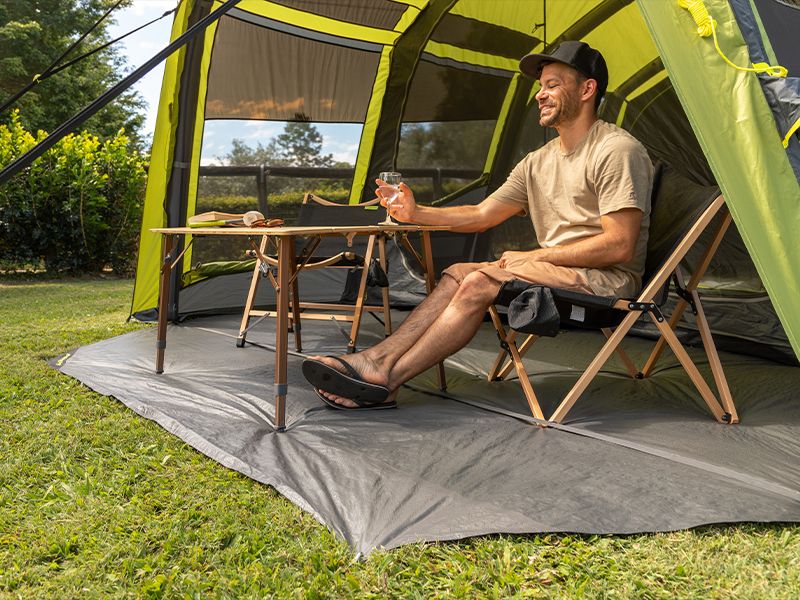Yes, putting a ground sheet (or footprint) under your tent is highly recommended for most camping situations. Here's why:
Benefits of Using a Ground Sheet Under Your Tent
Benefits of Using a Ground Sheet Under Your Tent
Using a tarp under your tent has more pros than cons. While some modern tents have built-in ground covers attached to the underside, most tents do not come standard with footprints. A tarp is a cost-effective substitute.
Unbeknownst to many, the true purpose of a ground sheet, be it a tarp or a footprint, is to protect the exterior of your tent.
Good quality tents can last decades, but they are not the cheapest. Using a ground cover can extend the life of your tent by many years. Especially if you have invested in a good quality tent, you want it to last a few years.
Unless you only camp at campsites with grass patches, you will expose your tent to rugged terrain with sharp rocks, stones, and tree roots that can puncture and tear the bottom of your tent.
It is far cheaper to replace a tarp than a tent. For this reason alone, it is worth using a tarp under your tent.
Whether you are backpacking or simply prefer wild camping, any added layers are welcome when you sleep on the ground!
A tarp under your tent helps soften the floor and makes any uncomfortable stones and roots slightly more bearable. A tarp will protect your mat from punctures and prevent deflating if you sleep on a sleeping mat.
Tents can be annoying to clean. Add mud, dirt, and pine needles stuck to the bottom of your tent, and you are in for an unpleasant time.
While you will still need to wash your tent occasionally, cleaning the tarp is far easier than cleaning your tent. A tarp will also make packing up effortless.
As the earth cools at night, the air above the ground cools, and condensation forms in the form of dew. Adding a tarp under your tent creates a barrier between your tent and the cool, dewy earth beneath, which will help prevent moisture under your tent.
The tarp will also protect your tent from condensation inside the tent as it lowers the temperature difference between the tent’s surface and the ground.
Most tarps are made from waterproof material and act as fantastic insulators.
While insulation is not the most important function of a tarp, a tarp will make your tent a little warmer inside. A welcome perk during winter camping!
Most tents have a footprint that fits. If you can't buy a tarp that fits, they are easy enough to make.
While a tarp is mostly beneficial, using the wrong size tarp can cause more problems than the tarp is meant to solve. It is, therefore, crucial to use the correct size tarp.
If you are using a tarp under your tent as a tent “footprint,” the tarp needs to be the same size as your tent floor. However, a slightly smaller (an inch or two) tarp works better. As a general rule, your tarp is too big if you can see the tarp sticking out under the tent.
Many campers use tarps that are too big and end up with water under their tents when it rains. A small tarp will prevent water from pooling under your tent. For a more detailed guide on the correct size for a tarp, check out our post on choosing the best tarp size.
Tarps are not expensive. They are certainly cheaper than a custom footprint. However, they are also super easy to make and will save you even more money!
When making a tarp, look for a strong material that is durable, not easy to puncture, and waterproof or water-resistant.
Tyvek is extremely popular for DIY tarps for a good reason. Tyvek is lightweight, breathable, very durable, and waterproof! Another popular material used for tarps is plastic sheeting or Polycro. Also known as a painter’s drop cloth, Polycro is waterproof, tear-resistant, and extremely durable. Tarpaulin is heavier and bulkier, more suitable for camping than backpacking.
To make your own tarp, you will need:
If you don’t know the measurements of your tent floor, you will need to set up your tent to measure the length and width. You only need a rough measurement to buy the tarp, so measuring the longest and widest part of your tent will be sufficient.
For tents with vestibules, you can include them in your measurement to create a little porch or mudroom, although this is optional. To be safe, you can buy slightly larger than your measurements.
Measuring the size of your tarp is easiest on a flat surface. The flatter the surface, the better. A flat area on your lawn will work perfectly, but if you don’t have access to a flat surface outside, the living room or other indoor area will work just as well.
To remove any folds that may be there, you can place anything heavy, like a shoe or hammer, on the folds and roughly “iron” out the folds. Add some weights to the corners if needed.
Pitch your tent and place it on top of the tarp. There is no need to add the rain cover over the tent.
If you are working outside, tracing is easiest when the tent is secured with pens. The tighter the tent, the more accurate the measurements will be. For indoor spaces, you can add weights to the tent’s edges on the inside to secure it in place.
As the tarp needs to be the same size as the tent floor or smaller, tracing is the simplest method to measure the tarp.
Use the marker to trace the tarp around the tent floor. Be careful not to mark your tent. Weights come in handy here! Tracing is particularly helpful if you have an irregular-shaped tent or a tent with rounded edges.
You can make your own tarp out of the canvas drop clothes that painters use.
Once you have traced around the tent, you can cut your tarp. Materials such as Tyvek and Polycryo won’t fray, so there is no need to add seams.
You can cut on the markings, but cutting an inch or two smaller ensures you don’t have any tarp sticking out from under the tent.
You don’t technically need anchor tabs, but they help secure the tarp to the ground, and as they are so affordable, there’s really no reason not to get them.
Anchor tabs replace the grommets in store-bought tarps. Most pre-cut tarps and ground covers have grommets around the edges, making securing the tarp to the ground easier. These anchor tabs from Amazon are self-adhesive, and you don’t need any tools.
When camping, just lace a rope through the tabs and secure the rope to the tent pens or poles. Easy as that!
The durability of the tarp and its ability to resist tears and punctures are more important than the thickness of the material.
For hikers and backpackers, the thickness of your tarp will be determined by the amount of weight you are capable of or willing to carry, the distance you are hiking, and the amount of space in your backpack. Polycro is lighter than Tyvek and, therefore, a better option if weight is a factor.
A thicker tarp provides extra protection against sharp sticks and stones, but can be a bit bulky. If you are car camping and have sufficient packing space, buy a thick tarp like a thick Tyvek or Tarpaulin. The extra bulk will be worth it!
Make sure your tarp doesn't poke out from under the edges of the tent so it does its job properly!
Placing a tarp under a tent is easy, but many campers, especially newbies, don’t know how to correctly place a tarp under a tent. This can lead to some problems, especially when it rains.
Before setting up your tarp and tent, find a clear spot to camp and remove any visible rocks, sticks, or other items that can tear your tent. Although you are using a tarp, removing obvious obstructions will make you sleep more comfortably and is good practice.
Your tarp must be the same size or smaller than your tent floor. However, if you only have a bigger tarp than your tent, you can still use it as a footprint. All you need to do is hide the tarp’s edges under the tent.
Here comes the part many get wrong: make sure that you fold under so that the extra piece of tarp is under both the tent and the tarp, and not between the tarp and the tent floor. Folding the tarp down like this will prevent water from pooling under the tent.
